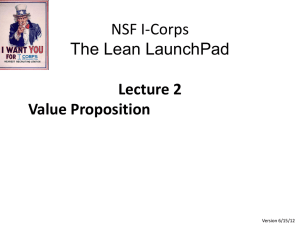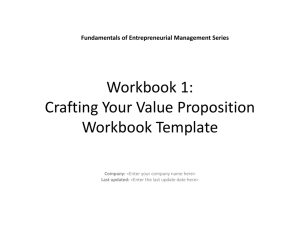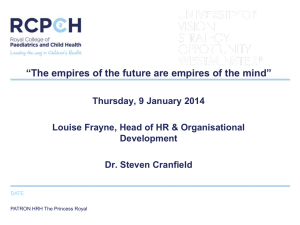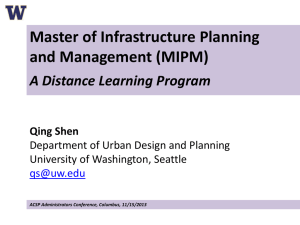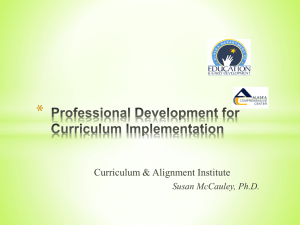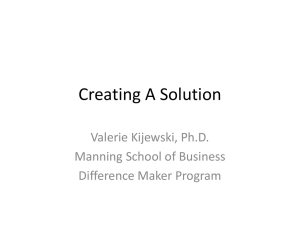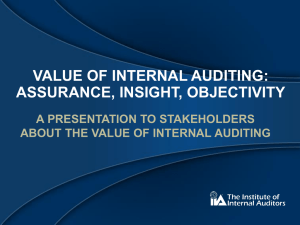Lean Startup Principles & Minimum Viable Products
advertisement
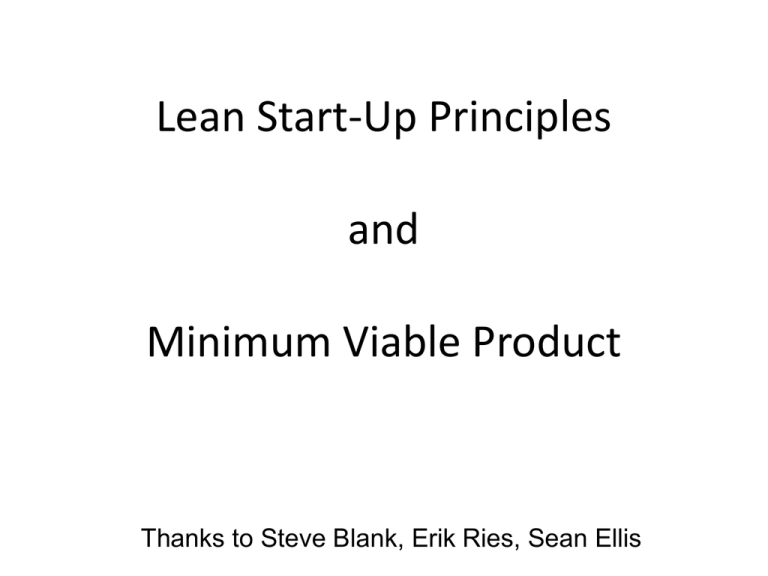
Lean Start-Up Principles and Minimum Viable Product Thanks to Steve Blank, Erik Ries, Sean Ellis What are the Lean Startup Principles? • Nail it then scale it • Rapid hypothesis testing about market, pricing, customers (customers & markets unknown) • MVP (Minimum viable product) • Low burn by design (no scaling until revenue) • Metrics, iteration, agile development • Learn fast (fail fast) Founder’s Job • Search for Minimum Viable Product (“MVP”) and Scalable Business Model • How? Scalable Startup Transition Real Business Unknown customer needs Unknown feature set Unknown business model Model found by iteration Source: Steve Blank What is MVP? • Minimum Viable Product – Part of the “Lean Startup” methodology espoused by Eric Ries Eric Ries’ definition: – The minimum viable product is that version of a new product which allows a team to collect the maximum amount of validated learning about customers with the least effort. – Big vision meets rapid, metrics-based iteration Problem Definition Process • What is the basic need/problem? • What is the desired outcome? • Who stands to benefit and why? • How is it solved now? Before Coding • Test/validate that the problem you are solving – Actually exists – Is (painful) worth solving (customers will pay for it) – Is widespread (big market) – Is solved by your minimum feature set Minimum Viable Product http://web.archive.org/web/20070701074943/http://blog.pmarca.com/2007/06/the-pmarca-gu-2.html Why? • Save time and money – Spend imagination before money – Engineer risk out of product and model – Run lots of experiments Value Proposition What Are You Building and For Who? © 2012 Steve Blank Product/Market Fit Pain Killers Reduce or eliminate wasted time, costs, negative emotions, risks during and after getting the job done Pain = Customer Problem Gain = Customer Solution The Value Proposition Gain Creators Products & MVP Services Pain Killers Pain Killers - Hypotheses • Produce savings? – (e.g. time, money, or efforts, …) • Make your customers feel better? – (e.g. kills frustrations, annoyances, things that give them a headache, ...) • Fix underperforming solutions? – (e.g. new features, better performance, better quality, ...) • Ends difficulties and challenges customers encounter? – (e.g. make things easier, helping them get done, eliminate resistance, ...) • Wipe out negative social consequences? – (e.g. loss of face, power, trust, or status, ...)... • Eliminate risks – (e.g. financial, social, technical risks, or what could go awfully wrong, ...) Pain Killer – Is it a Problem or Need? • Are you solving a Problem? • Are you fulfilling a Need? • For who? • How do you know? Pain Killer - Ranking • Rank each pain your products and services kill according to their intensity for the customer. • Is it very intense (appendicitis) or very light (annoying)? • For each pain indicate the frequency at which it occurs Gain Creators How do you create benefits the customer expects, desires or is surprised by, including functional utility, social gains, positive emotions, and cost savings? Gain Creators- Hypotheses • Create savings that make your customer happy? – (e.g. in terms of time, money and effort, ...) • Produce expected or better than expected outcomes? – (e.g. better quality level, more of something, less of something, ...) • Copy or outperform current solutions that delight customer? – (e.g. regarding specific features, performance, quality, ...) • Make your customer’s job or life easier? – (flatter learning curve, usability, accessibility, more services, lower cost of ownership, ...) • Create positive consequences that customer desires? – (makes them look good, produces an increase in power, status, ...). Gain Creator- Ranking • Rank each gain your products and services create according to its relevance to the customer. • Is it substantial or insignificant? • For each gain indicate the frequency at which it occurs. Minimum Viable Product Define Minimum Viable Product – Physical • First, tests your understanding of the problem (pain) • Next tests your understanding of the solution (gain) – Proves that it solves a core problem for customers • The minimum set of features needed to learn from early evangelists - Interviews, demos, prototypes, etc - Lots of eyeball contact Define the Minimum Viable Product – Web/Mobile • NOW build a “low fidelity” app for customer feedback – tests your understanding of the problem • LATER build a “high fidelity” app tests your understanding of the solution – Proves that it solves a core problem for customers – The minimum set of features needed to learn from earlyvangelists - Avoid building products nobody wants - Maximize the learning per time spent The Art of the MVP • A MVP is not a minimal product • “But my customers don’t know what they want!” • At what point of “I don’t get it!” will I declare defeat? Things to Consider Value Proposition – Common Mistakes • It’s just a feature of someone else’s product • It’s a “nice to have” instead of a “got to have” • Not enough customers care Questions for Value Proposition • Competition: What do customers do today? • Technology / Market Insight: Why is the problem so hard to solve? • Market Size: How big is this problem? • Product: How do you do it? Key Questions for Value Prop • Problem Statement: What is the problem? • Ecosystem: For whom is this relevant? • Competition: What do customers do today? • Technology / Market Insight: Why is the problem so hard to solve? • Market Size: How big is this problem? • Product: How do you do it? Technical Versus Market Insight Technology and Market Insight Technology Insight • Moore’s Law • New scientific • discoveries Typically applies to hardware, clean tech and biotech Market Insight Value chain disruption Deregulation Changes in how people work, live and interact and what they expect Examples of Technical Insight • Security framework to secure the internet of things Re-programmable ASICs Examples of Market Insight • People want to play more involved games than what is currently offered • Facebook can be the distribution for such games Masses of people are more likely to microblog than blog The non-symmetric relationships will allow companies and individuals to self-promote and will impact distribution European car sharing sensibilities could be adopted in North America People, particularly in urban environments, no longer wanted to own cars but wanted to have flexibility. Types of Value Propositions Comes from Market Insight Comes from Technical Insight More Efficient Lower cost Smaller Faster Better Distribution Simpler Better Branding Better Bundling Growing Valuable “Normal” Startup Scale Get Efficient Conversion Product/Market Fit (Value) Creating Value: Normal Startup • Product/market fit = product is “must have” (value) • Become a “must have” with customer development – Validate “value” assumptions early (who needs/why?) – Get users on first release ASAP – Find “must have” users/use cases – Facts outside building (interviews then surveys) – Pivot if necessary to create value Key “Value” Question in Surveys “How would you feel if you could no longer use Product?” “Very Disappointed” My Recommendation 0% – 25% Keep burn low, engage, iterate 26% – 39% Try repositioning, retargeting 40% – 100% Proceed up pyramid Iterate, Pivot, A/B Testing Customer Discovery Customer Validation Run lots of experiments Talk to lots of customers Test hypothesis Rinse and repeat Source: Steve Blank Customer Creation Build Company How Zynga Uses MVP From Mark Pincus, CEO & Founder – Create a 5-word pitch for a new product or feature – Put it up on a high traffic webpage – If it gets clicks, collect the emails of interested customers – Build a ‘ghetto’ version of the product or feature – Test everything – Iterate constantly Source: http://grattisfaction.com/2010/01/how-zynga-does-customer-development-minimum-viable-product/ In-Class Exercise • Pick any 3 teams who presented today • Tell us who you think their customers will be. Why? • How many customers do they need to talk to before they have relevant data? Deliverables for Next Week • • • • User / customer hypotheses? Did you learn anything different? Did your Value Proposition change? What are your customer acquisition cost hypotheses? • What are the benefits (economic or other)? • If part of a company, who’s the decision maker, how large is the budget and how will the buying decision be made? • Web startups: start coding the product! One Way

